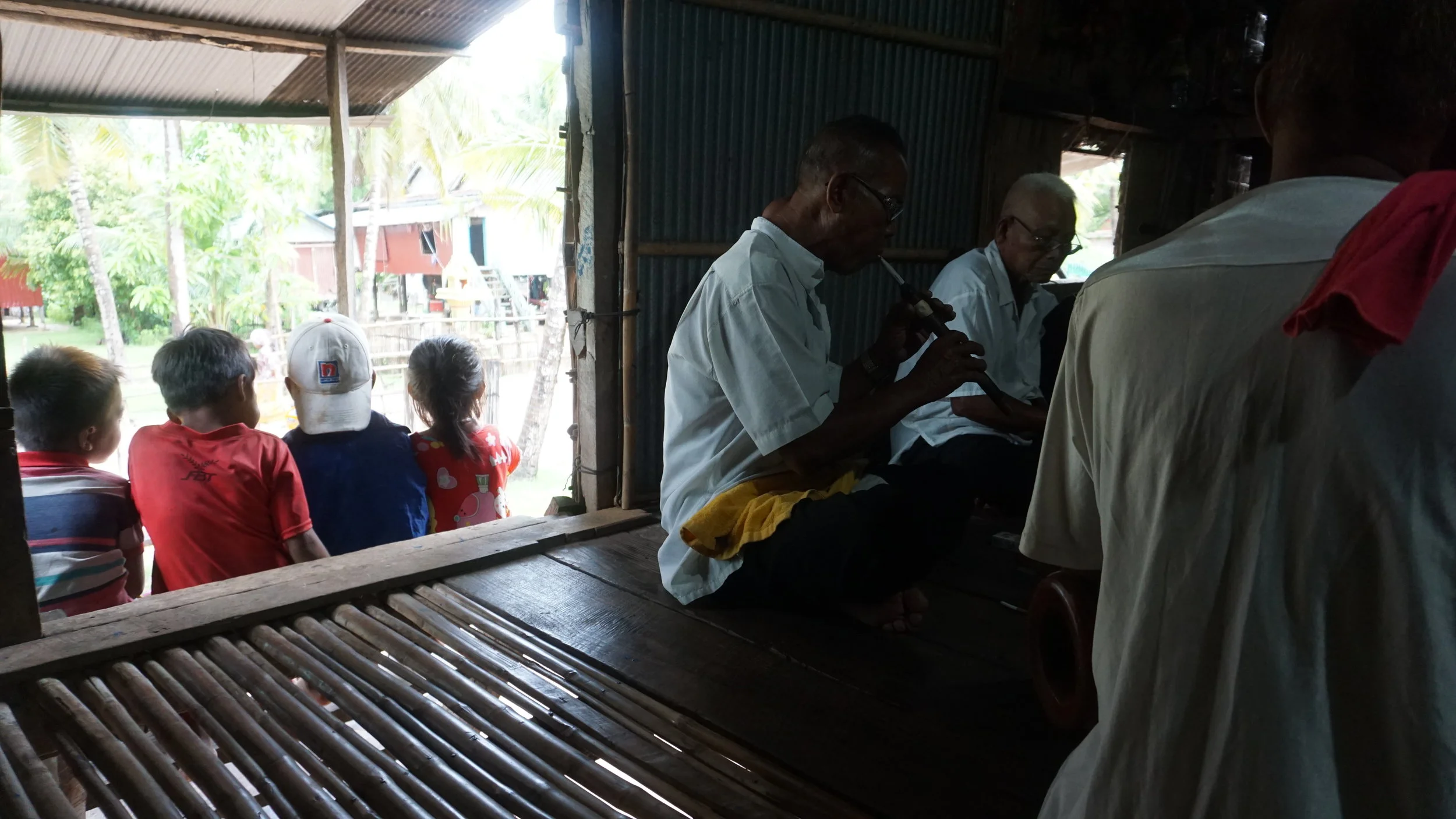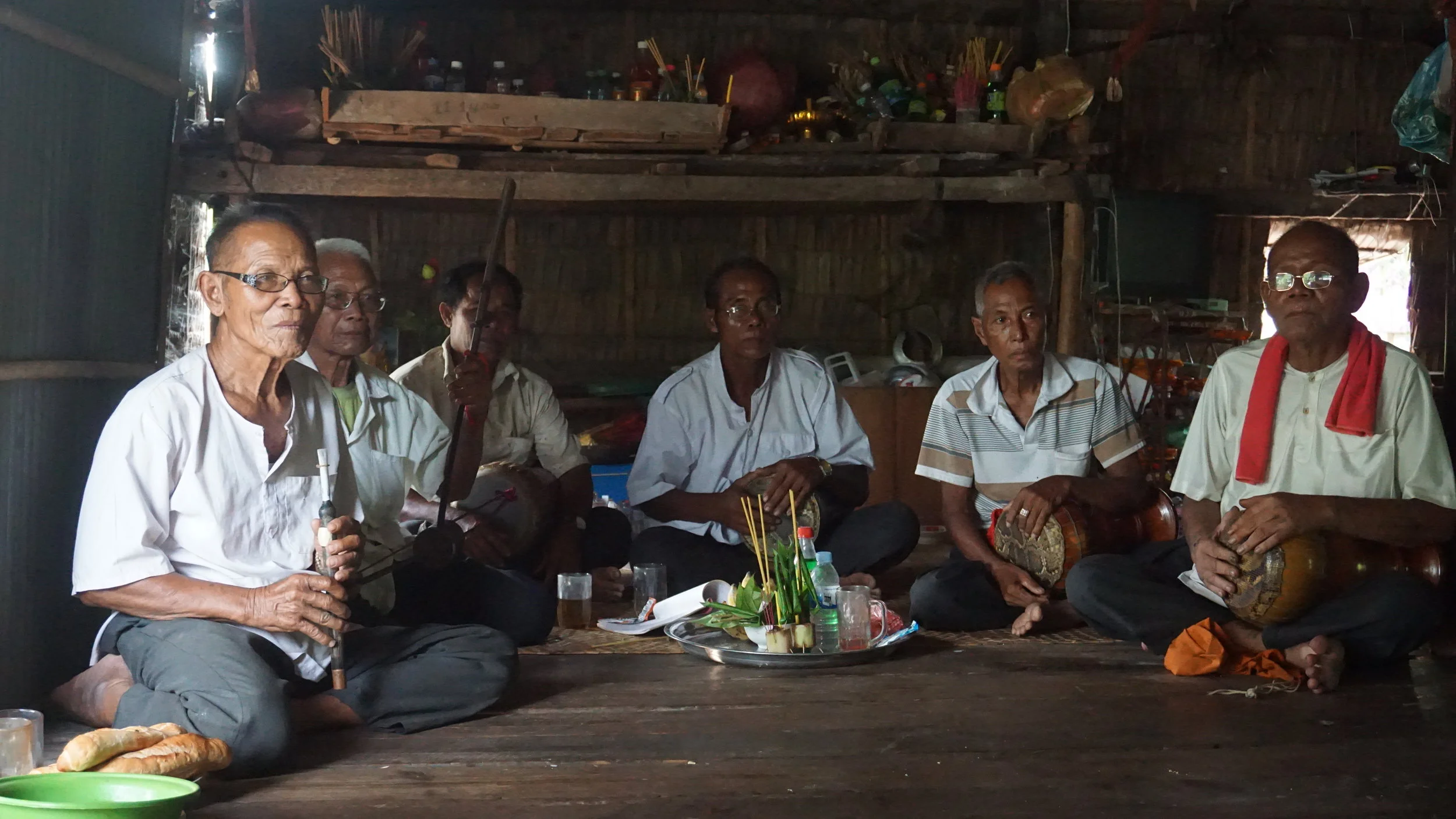Ly Mut’s Phleng Arak Ensemble, Kampong Thom
Chaem Kha (ឆែម ខា) vocals and drum | Ly Mut (លី មុត) tro sau | Yang Ho (យ៉ង ហូ) pei pok |
Thab Pai (ថាប់ ប៉ៃ) vocals and drum | Pot Nen (ពត នេន) vocals and drum | Sum Pheng (ស៊ុំ ផេង) vocals and drum
Phleng Arak (ភ្លេងអារក្យ) is a Cambodian music used to incite spirit possession.
An offering to the spirits must be made before any song can be played
Arak (អារក្យ) spirits are generally understood to be malevolent and to be responsible for illness and death in the community; ritual ceremonies are prescribed by a Kru Khmer (គ្រូខ្មែរ) traditional healer as a means of enabling a community to make offerings to and commune with the Arak in the hope of ultimately appeasing it, thereby healing the sick person.
Believed to be the oldest form of Cambodian music continually in use, Phleng Arak is a ritual offering meant to entice an Arak spirit to possess a medium. Different songs are believed to have different powers: some are meant to call the spirit, some to entertain the spirit on its journey to possess, and others are meant to entertain the spirit upon its arrival. After entering the medium, the Arak then acts, speaks, and dances through the medium, then answers questions from community members attending the ritual before leaving.
As medicine supplants or supplements spiritual healing practices in many parts of Cambodia, Phleng Arak is becoming quite rare. There are few young musicians who desire to learn from the culture-bearers, and much knowledge will be lost when these older musicians pass away.
Musicians sit in a circle around the offering while playing.The drums are believed to be of critical importance, as they are the instruments that most rouse the spirits; ensembles typically feature four drummers.
In August 2018, my colleagues and I had the privilege of recording 36 songs from Ly Mut’s band in Kampong Thom. We believe this to be all or nearly all of the band’s repertoire. When we returned to the village to meet with the group’s leader, Ly Mut, in December, we arrived to the sound of Buddhist funereal chanting and learned that one of the musicians, ពត នេន, had died just a week before. We dedicate these recordings to him and to his family.
You can listen to recordings of another Phleng Arak ensemble here.
1. នគរាជ | Nokoreach
2. រាមន្ត | Reamun
3. ស្តេចផ្ទុំ | Sdach Phtum
4. ស្វាបរពល | Sva Borpol
5. ភ្នំស្រួច | Phnom Sruoch
6. សសរកន្លោង | Sawsar Konlong
7. កន្សែងក្រហម | Konsaeng Krahom
8. គោស | Ko Saw
9. ជុំគ្រែ | Jom Kre
10. ជឺតមន | Jut Mon
11. ប្អូនមាសពិសី | P’oun Meas Pisei
12. ទន្សោង | Tonsaong
13. ផាត់ជាយ - សំពោង | Phat Cheay - Sampong
14. សូរិយា | Soriya
15. នគរាជ - ចានស្រីបែក | Nokoreach - Jan Srei Baek
16. ម្លប់ដូង | Mlop Dong
17. មហោរី | Mohaori
18. ក្រោមនាយ | Krom Niey
19. អ៊ួក | Uok
20. មាន់រងាវ | Moan Rongiev
21. ព្រៃឯកើត | Prey Ae Kaet
22. ស្រគំគាល | Srokom Keal
23. តន់តូច | Ton Touch
24. ផ្គរលាន់ឯជើង | Pkor Loan Ae Jeung
25. ជឹត | Jit
26. ចុងខ្លម | Jong Khlom
27. ទ្រាំង | Treang
28. ព្រះថោង | Preah Thong
29. អក | Ak
30. តីនាងវង | Tei Neang Vong
31. អុំទូក | Om Touk
32. កំប៉ោរ | Kom Por
33. បទភ្លេងក្ងោក | Bat Phleng K’ngok
34. អាជ្វា | Achvea
35. លោមនាង | Lom Neang
36. បេះផ្កា | Beh Phka
Research Team: Emily Howe, An Raksmey, Tola Say
Recording and Mastering: Sebastien Robert







